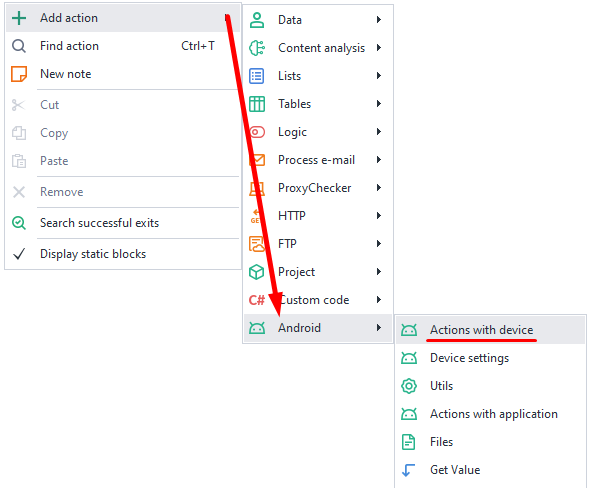Actions with Device (Enterprise)
Please read the Material Usage Rules on this site.
How to add an action to a project?
To open the context menu, right-click on an empty space.
Then select Add Action → Android → Actions with Device.

How to select a device?
This action lets you pick a device to work with.
Available settings:
- Full name or index
Enter the device's serial number or index (starts from zero). If you leave this empty, a random device will be chosen. - Regex
If you choose this option, a random device will be picked from the list of all connected devices whose serial numbers match your Regex expression. - Put index/name in variable
This lets you save the chosen device's name or index to variables. Usually this is used with random selection, so you know which device was picked.
How to start or restart a device?
This action starts a connection to the selected device and begins interacting with it, or restarts an existing connection.
Before you start, make sure you've selected the device you want the program to work with.
How to stop a device?
This action stops a running device.
How to rename a device?
Lets you change the name of the current device.
Please note:
The name changes for the device selected using the Select feature (described earlier in this article).
How to get a list of devices?
This action allows you to save all available devices to a list.

Available settings:
- What to get
You can choose what exactly to save in the list: either the device indexes or their serial numbers. - Filter
You can also filter the list by device state:- All. Includes all created devices, regardless of their state.
- Busy. The device is busy in one of the running threads. This works only when run in ZennoDroid. (ProjectMaker doesn't see threads running in ZennoDroid).
- Not busy. The device isn't in use by any running thread. This filter also works only in ZennoDroid.
- Running. The device is connected to your computer and there is communication through ADB.
- Not launched. The device is connected, but there's no communication via ADB. For example, the device isn't authorized or is offline.
- Put to list
This is the list where the result will be saved.